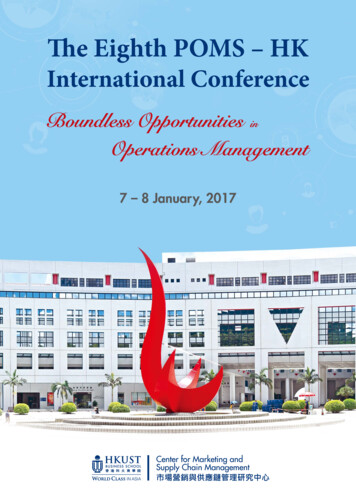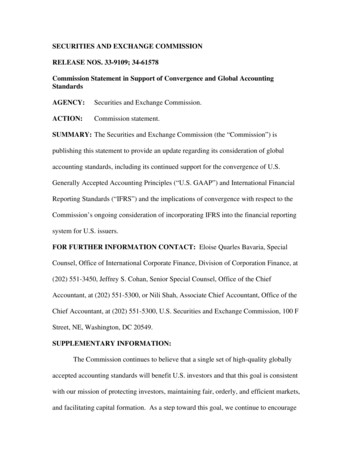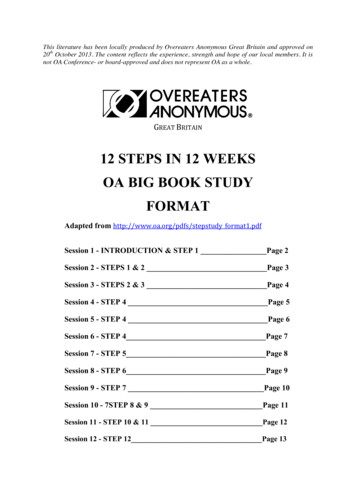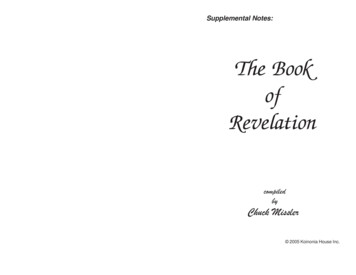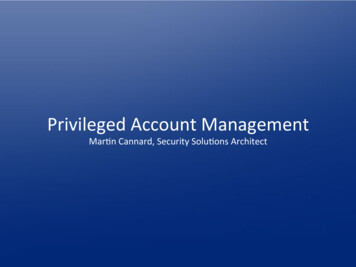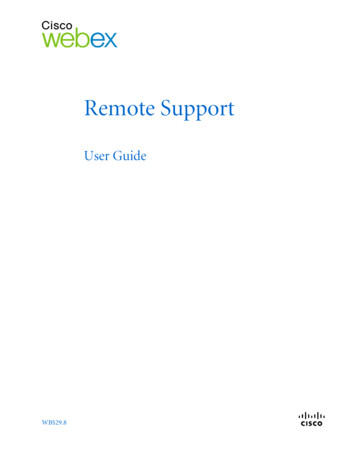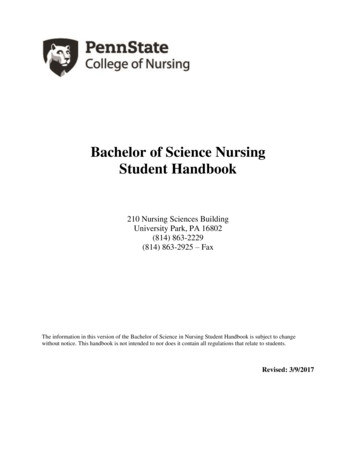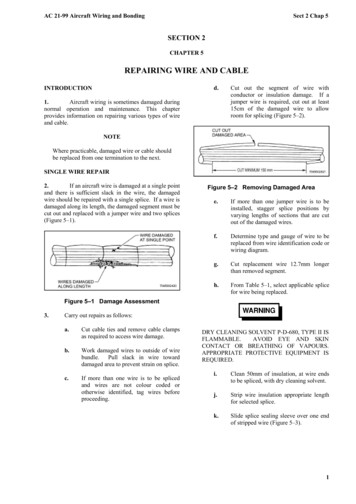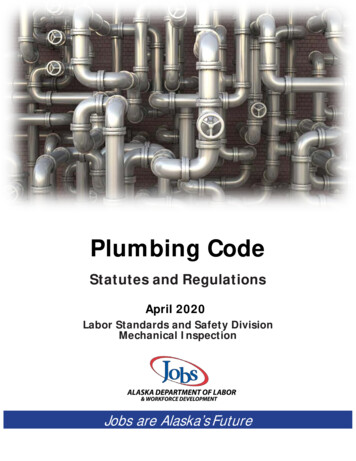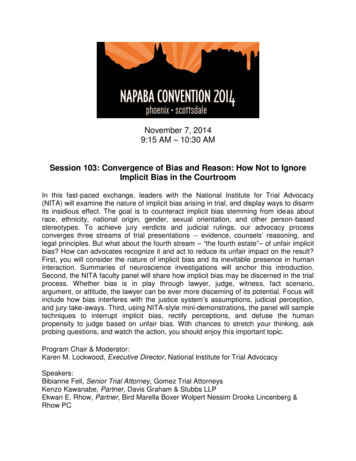
Transcription
November 7, 20149:15 AM – 10:30 AMSession 103: Convergence of Bias and Reason: How Not to IgnoreImplicit Bias in the CourtroomIn this fast-paced exchange, leaders with the National Institute for Trial Advocacy(NITA) will examine the nature of implicit bias arising in trial, and display ways to disarmits insidious effect. The goal is to counteract implicit bias stemming from ideas aboutrace, ethnicity, national origin, gender, sexual orientation, and other person-basedstereotypes. To achieve jury verdicts and judicial rulings, our advocacy processconverges three streams of trial presentations -- evidence, counsels’ reasoning, andlegal principles. But what about the fourth stream – “the fourth estate”– of unfair implicitbias? How can advocates recognize it and act to reduce its unfair impact on the result?First, you will consider the nature of implicit bias and its inevitable presence in humaninteraction. Summaries of neuroscience investigations will anchor this introduction.Second, the NITA faculty panel will share how implicit bias may be discerned in the trialprocess. Whether bias is in play through lawyer, judge, witness, fact scenario,argument, or attitude, the lawyer can be ever more discerning of its potential. Focus willinclude how bias interferes with the justice system’s assumptions, judicial perception,and jury take-aways. Third, using NITA-style mini-demonstrations, the panel will sampletechniques to interrupt implicit bias, rectify perceptions, and defuse the humanpropensity to judge based on unfair bias. With chances to stretch your thinking, askprobing questions, and watch the action, you should enjoy this important topic.Program Chair & Moderator:Karen M. Lockwood, Executive Director, National Institute for Trial AdvocacySpeakers:Bibianne Fell, Senior Trial Attorney, Gomez Trial AttorneysKenzo Kawanabe, Partner, Davis Graham & Stubbs LLPEkwan E. Rhow, Partner, Bird Marella Boxer Wolpert Nessim Drooks Lincenberg &Rhow PC
PROGRAM DESCRIPTION FOR NAPABA 2014 NATIONAL CONFERENCESubmitted on July 21, 2014 at the following link:https://docs.google.com/forms/d/1y ?usp form confirm“Convergence of Bias and Reason: How Not To Ignore Implicit Bias in the Courtroom”In this fast-paced exchange, leaders with the National Institute for Trial Advocacy (NITA) willexamine the nature of implicit bias arising in trial, and display ways to disarm its insidious effect. Thegoal is to counteract implicit bias stemming from ideas about race, ethnicity, national origin, gender,membership in the LGBT community, and other person-based stereotypes.To achieve jury verdicts and judicial rulings, our advocacy process converges three streams oftrial presentations -- evidence, counsels’ reasoning, and legal principles. But what about the fourthstream – “the fourth estate” if you will – of unfair Implicit Bias? How can advocates recognize it, and actto reduce its unfair impact on the result?First, you will consider the nature of implicit bias and its inevitable presence in humaninteraction. Summaries of neuroscience investigations will anchor this introduction.Second, the NITA faculty panel will share how implicit bias may be discerned in the trial process.Whether bias is in play through lawyer, judge, witness, fact scenario, argument, or attitude, the lawyercan be ever more discerning of its potential. Focus will include how bias interferes with our justicesystem’s assumptions, judicial perception, and jury take-aways.Third, using NITA-style mini-demonstrations, the panel will sample techniques to interruptimplicit bias, rectify perceptions, and defuse the human propensity to judge based on unfair bias.With chances to stretch your thinking, ask probing questions, and watch the action, you shouldenjoy this important topic.S:\\.NITA appearances\NAPABA conference 2014\Convergence of Bias and Reason - July 21 14 speakerinfo & program description.docxsubmitted online 11/2/2014 2:42 PM
NITA. All rights reserved.
TIMED AGENDA FOR CLE PROGRAM atNAPABA 2014 NATIONAL CONFERENCE (Nov. 7, 2014)Submitted August 4, 2014TITLE:Convergence of Bias and Reason: How Not To Ignore Implicit Bias in theCourtroomDATE AND TIME:November 7, 2014, 9:15 – 10:30 amORGANIZATION:National Institute for Trial Advocacy (NITA)SPEAKERS:Program Chair & Moderator:Karen M. Lockwood, Executive Director & Faculty Member, NITA, BoulderPanelists:Bibianne U. Fell, Senior Trial Attorney, Gomez Trial Attorneys, San DiegoKenzo Kawanabe, Partner, Graham & Stubbs, DenverEkwan E. Rhow, Partner, Bird Marella Boxer Wolpert Nessim DrooksLincenberg & Rhow PC, Los AngelesAGENDA9:15 – 9:30Orientation to Implicit BiasModerator, with panel input, will present key points from scientific evidence and the growingbody of research on implicit bias. This includes the nature of implicit bias, its inevitable presencein human interaction, and the difference between bias and implicit bias. Summaries ofneuroscience investigations will anchor this thematic and research-based orientation. Points tobe presented include the distinction between bias and implicit bias, the prominence of implicitbias in every human brain without exception, the impact on human perception, the role it playsin formation of judgments, and more. Significant and growing bodies of experimental socialpsychology and neuroscience research provides a firm basis on which lawyers can begin tounderstand and accept that implicit bias is real, ever-present, and possible to disarm.See PowerPoint slide set submitted herewith.See sample literature listing, which will be expanded as the panel completes its preparation(attached).9:30 – 9:50Panel Discussion on Detecting the Situational Risks of Unwanted Implicit BiasSpeaking from their trial experience and their experience as lawyers from various cities in theUnited States, the panelists will engage each other and the audience in a fast-paced discussionNITA CLE “Convergence of Bias and Reason: How Not to Not To Ignore Implicit Bias in the Courtroom (NAPABAConvention 2014)Submitted Sunday, November 02, 2014
of key aspects of the trial process where bias can play a significant – if hidden – role. Based ontheir experiences, they will review the ways in which they learned to recognize bias, and offersuggestions for anticipating it.9:50 – 10:20Demonstrations Using A Trial Scenario Of Tips for Counteracting Implicit Bias DuringTrial PresentationsIf the situational risk of bias – or actual implicit bias at work – can be detected by trial counsel,are there ways to defuse that bias, for the purpose of advocating a just result based on law andfacts without unwanted implicit bias? The NITA Faculty will demonstrate such situations, andhow they may choose to prepare in anticipation, to conduct their examination differently, tocomment on bias, and other ways to counter its effect.10:20 – 10:30 Wrap-Up AnalysisThe Moderator and Panelists will comment upon the demonstrations, and upon questionspresented by the audience.NITA CLE “Convergence of Bias and Reason: How Not to Not To Ignore Implicit Bias in the Courtroom (NAPABAConvention 2014)Submitted Sunday, November 02, 2014
LITERATURE LIST FOR CLE PROGRAM atNAPABA 2014 NATIONAL CONFERENCE (Nov. 7, 2014)Submitted August 4, 2014TITLE:Convergence of Bias and Reason: How Not To Ignore Implicit Bias in theCourtroomDATE AND TIME:November 7, 2014, 9:15 – 10:30 amORGANIZATION:National Institute for Trial Advocacy (NITA)Following is a listing of some of the research and other resources that help the trial lawyer understandand recognize implicit bias.1. Implicit Assumptions Self-Test: https://implicit.harvard.edu/implicit/demo. Experiment (inconfidence) on any of several instruments that will challenge and reveal your own implicitbiases.2. How (Un)ethical Are You?, M. Banaji et al, Harv. Bus Rev. (2003): Entry-level discussion placingimplicit bias on the “charts” for recognition and examination. Identifies the location in the brainthat stores and employs key assumptions, the immutable nature, and the kind of research thathas revealed its presence.3. The Development of Implicit Attitudes: Evidence of Race Evaluations From Ages 6 and 10 andAdulthood, Baron et al, Psychological Science 17.1 (2006)4. Cognitive Biases Make Judges and Jurors Believe Weird Things, SciTech Lawyer (Fall 2013),available at http://tinyurl.com/luxc63c.5. Neuroethics Journal Club: Neural Correlates of Negative Sterotype. (Dec. 3, 2013), available ion\Private\Karen - Britta\Marketing\NITA appearances\NAPABA conference 2014\NITA-RESEARCH SOURCES LISTING for CLE PROGRAM at NAPABA 2014.docxsubmitted Sunday, November 02, 2014
NITA CLE “Convergence of Bias and Reason: How Not to Not To Ignore Implicit Bias in the Courtroom (N APABA Convention 2014) Submitted Sunday, November 02, 2014 TIMED AGENDA FOR CLE PROGRAM at NAPABA 2014 NATIONAL CONFERENCE (Nov. 7, 2014) Submitted August 4, 2014 TITLE: Convergence
